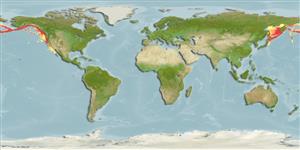Environment: milieu / climate zone / depth range / distribution range
Ecology
Marine; bathydemersal; oceanodromous (Ref. 51243); depth range 175 - 2740 m (Ref. 6793), usually 175 - 1450 m (Ref. 10935). Deep-water; 64°N - 23°N, 141°E - 109°W
North Pacific: Bering Sea coasts of Kamchatka, Russia and Alaska southward to Hatsu Shima Island, southern Japan and Cedros Island, central Baja California, Mexico in the eastern Pacific.
Length at first maturity / Size / Weight / Age
Maturity: Lm 60.3, range 58 - 62 cm
Max length : 120 cm TL male/unsexed; (Ref. 9988); common length : 80.0 cm TL male/unsexed; (Ref. 9988); max. reported age: 94 years (Ref. 55701)
Dorsal spines (total): 19 - 27; Dorsal soft rays (total): 16 - 20; Anal spines: 3; Anal soft rays: 15 - 19. Dorsal fins well separated; 2nd dorsal fin sub equal to anal fin in size and form, and opposite in position. Reaches over 1 m in SL.
Body shape (shape guide): fusiform / normal; Cross section: oval.
Adults found on mud bottoms, from 305 (Ref. 2850) to 2,740 m depth (Ref. 2850). Young-of-the-year juveniles are pelagic and found on the surface and near-shore waters (Ref. 28499). Generally localized, but some juveniles have been found to migrate over 2,000 miles in 6 or 7 years (Ref. 28499). Feed on crustaceans, worms and small fishes (Ref. 4925). Most of the catch is marketed in Japan (Ref. 28499). Utilized fresh, dried or salted and smoked (Ref. 9988), can be steamed, pan-fried, broiled, boiled, microwaved and baked (Ref. 9988). The liver oil is rich in vitamin A and D (Ref. 4925). Reported to reach 57 kg in Ref. 2850.
Eschmeyer, W.N., E.S. Herald and H. Hammann, 1983. A field guide to Pacific coast fishes of North America. Boston (MA, USA): Houghton Mifflin Company. xii+336 p. (Ref. 2850)
IUCN Red List Status (Ref. 130435: Version 2025-1)
Threat to humans
Harmless
Human uses
Fisheries: highly commercial; aquaculture: likely future use; gamefish: yes; aquarium: public aquariums
Tools
Special reports
Download XML
Internet sources
Estimates based on models
Preferred temperature (Ref.
123201): 1.4 - 5.5, mean 2.5 °C (based on 599 cells).
Phylogenetic diversity index (Ref.
82804): PD
50 = 1.2500 [Uniqueness, from 0.5 = low to 2.0 = high].
Bayesian length-weight: a=0.01122 (0.00806 - 0.01563), b=2.98 (2.88 - 3.08), in cm total length, based on LWR estimates for this species (Ref.
93245).
Trophic level (Ref.
69278): 3.8 ±0.2 se; based on diet studies.
Generation time: 5.8 (4.9 - 7.8) years. Estimated as median ln(3)/K based on 23
growth studies.
Resilience (Ref.
120179): Very Low, minimum population doubling time more than 14 years (K=0.2; tm=6; Fec=100,000; tmax=94).
Prior r = 0.11, 95% CL = 0.07 - 0.16, Based on 10 full stock assessments.
Fishing Vulnerability (Ref.
59153): Moderate to high vulnerability (49 of 100).
🛈
Climate Vulnerability (Ref.
125649): High vulnerability (58 of 100).
🛈
Nutrients (Ref.
124155): Calcium = 16.1 [9.1, 38.6] mg/100g; Iron = 0.46 [0.23, 0.90] mg/100g; Protein = 17 [16, 18] %; Omega3 = 0.567 [0.254, 1.631] g/100g; Selenium = 32.5 [14.5, 79.2] μg/100g; VitaminA = 8.27 [1.99, 36.01] μg/100g; Zinc = 0.27 [0.18, 0.42] mg/100g (wet weight);
